China's Supreme Patents Court draft judicial interpretation on patent validity litigation
We recently sent out a questionnaire to gather our clients’ views on the draft judicial interpretation on patent validity litigation issued by China’s Supreme Patents Court. Thank you to all those who responded.
We filed the survey results, together with our comments, at China’s Supreme Patents Court (SPC) under the name of Lusheng law firm, a strategic partner of Rouse. We will provide analyses of the key issues raised in the SPC review in the future, and will let you know of any progress.
For now, we have prepared a summary of the results from the questionnaire and our comments:
QUESTION 1: In an appeal to the Court from a patent invalidation case before the re-examination board (i.e. an administration case before SIPO), if the decision has obviously incorrect points which have not been raised in the appeal, should the Court review and judge those points directly? (Article 2)
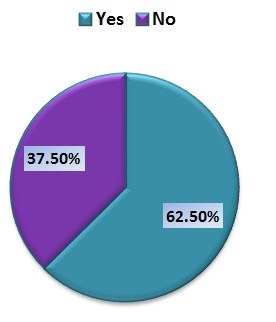
Most participants believe the Court should review and judge the points directly.
We agree with the majority of the participants, but care needs to be taken as the point may not have been fully argued before the Patents Review Board [is that right?] (PRB).
QUESTION 2: What should be the base(s) used to define or explain a term in the claims of patent in an appeal from a patent invalidation case before the re-examination board? (Articles 3-4)
1) Definition or explanation defined in the description and drawing(s) of the patent
2) Common understanding of a person skilled in the art
3) Patent review files (For example, the response documents submitted by the applicant during patent examination – file wrapper estoppel approach)
4) Statements in patent infringement litigation submitted or clarified orally by the patentee
5) Technical dictionary, technical manual, reference books, and textbooks (to the extent that this may differ from 2 above)
6) National standards and industry standards (to the extent that this may differ from 2 above)
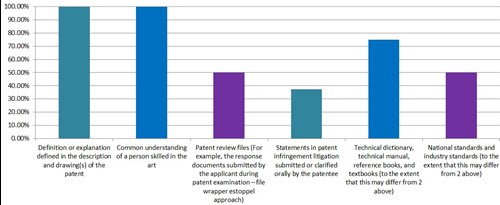
We think that: for bases 1, 5 and 6, if they are formed before the filing date, they definitely should be used to define or explain a term.
For base 2, it is too subjective, it needs corroborative evidence such as expert witness.
For base 3 if the patentee has expressly stated an interpretation to avoid prior art during prosecution then that should be considered.
For base 4, which requires statements to be submitted orally, they may be affected by context in the litigation, and therefore should be considered less.
QUESTION 3: Where the patent includes an obvious error, if an explanation can be derived by a person skilled in the art reading the claims, description, and drawings, should the Court judge based on that interpretation directly? (Article 5)
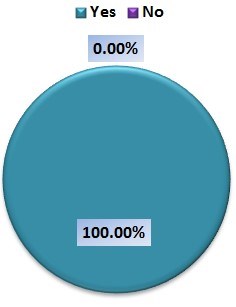
We agree with the participants.
QUESTION 4: The Court will declare relevant claims invalid if there is proof of deliberately fabricating and altering technical contents (description, drawings, data, and graphs) to support the claimed invention. Agree? (Article 6)
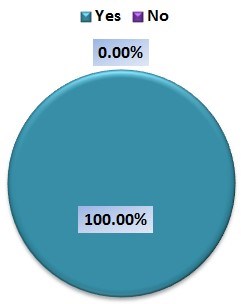
We agree with the participants.
QUESTION 5: What should be the test for an invention as claimed not being sufficiently disclosed? (Article 7)
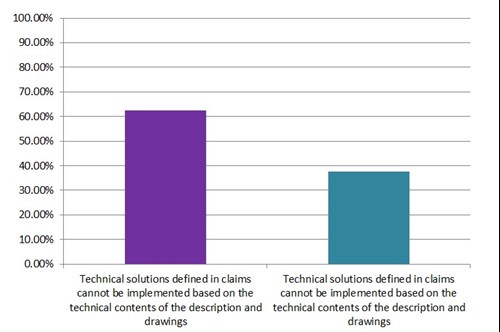
Most of the participant and we agree “Technical solutions defined in claims cannot be implemented based on the technical contents of the description and
drawings”. The “limited experiments” are too subjective.
QUESTION 6: What kind of post-filing supplementation of experimental data in chemical patents/patent applications should be reviewed by the Court? (Article 13)
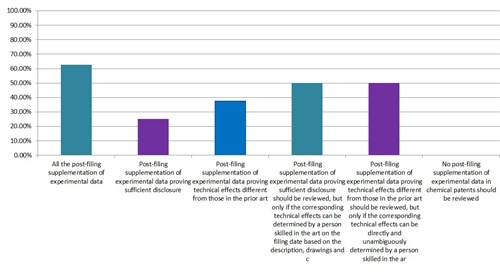
Both the participants and we agree that post-filing supplementation of experimental data in chemical patents should be reviewed. However, the acceptable levels are different. We tend to agree Post-filing supplementation of experimental data proving technical effects different from those in the prior art should be reviewed, but only if the corresponding technical effects can be directly and unambiguously determined by a person skilled in the art from the contents disclosed by the patent filing documents on the filing date.
QUESTION 7: The Court will require a party to prove the truth of experimental data when submitted in support of its argument. Agree? (Article 14)
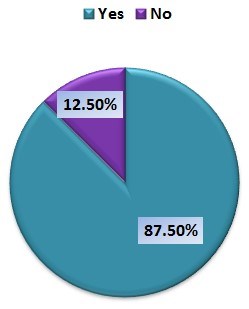
The overwhelming majority of the participants and we agree.
QUESTION 8: With reference to question 7 above, which of the following should be considered when proving the truth of the experimental data? (Article 14)
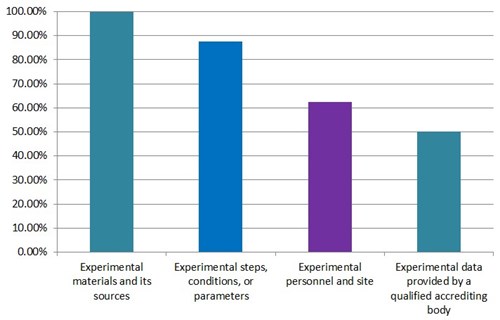
We think all the items should be considered as demonstrated by the responses we received.
QUESTION 9: Should the technical contents described by the “Background” part of the patent description be seen as accepted prior art? (Article 17)
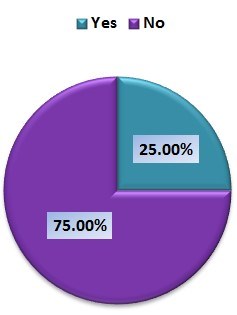
Most of the participants and we think that the technical contents described by the “Background” part of the patent description should not be accepted prior art. The usual position should be that you need to prove something is prior art particularly for obviousness considerations. It is not enough that it is simply mentioned in the Background.
QUESTION 10: If the Court revokes an invalidation decision of the patent re-examination board, should the Court need to send the case back to the re-examination board to reissue the decision? [Note: At present, the patentee has to obtain another decision reissued by the re-examination board] (Article 33)
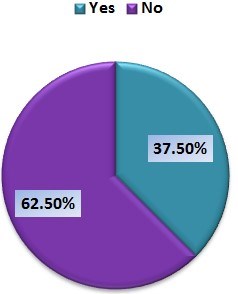
Most of the participants think the Court should not need to send the case back to the PRB.
We agree and think that the Court should have the discretion to send the case back to the PRB. However if there was no need to send it back to the PRB then they do not need to.
QUESTION 11: Design patent invalidation includes the ground that: “A design in which patent rights are granted shall not conflict with the legitimate rights obtained by others prior to the date of the patent application” (Article 23.3 of the Patent law). Should it only be the owner of the legitimate rights that can request invalidation based on that ground? [Note: the “legitimate rights” referred to are usually copyright, trademarks, landmarks, enterprise names, business names portraits, and specific names, packaging or decoration of well-known commodities, etc., although this is not limited to those rights] (Article 29)
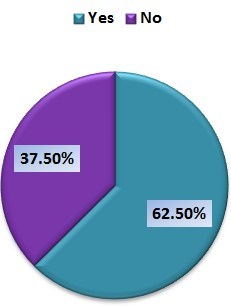
Most of the participants and we agree. If it is limited to the “legitimate rights” owner, it can avoid many irrelevant malicious actions and maintain the stability of patent rights.
QUESTION 12: Do you think it is reasonable to incorporate the concept of “design space” into all design patent cases? (Article 21) [Note: where the “design space” is relatively small, the Court may hold that common consumers are generally more likely to notice minor differences between different designs. For example, an alleged infringer would usually say that the design space is small to argue that its design does not infringe the asserted patent for noticeable minor differences in the small design space. Conversely, a design patent owner would argue the design space is large so noticeable minor differences would not avoid infringement].
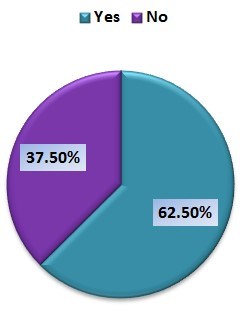
Most of the participants agree to incorporate the concept of “design space”. We think the incorporation should be treated very cautiously, because the concept of “design space” is too subjective. However, most designs will have some “design space” even if very small. In other words, they will not be limited to the exact design shown. This will come down to proof. See Question 13.
QUESTION 13: Do you think it is necessary to provide evidence supporting the asserted design space? (Article 21)
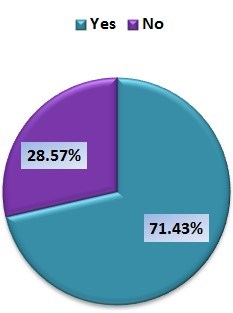
QUESTION 14: Following from question 13 above, if it is necessary to provide evidence when asserting the design space, then how many prior designs should be provided? (Article 21)
1) Less than 10
2) 10-50
3) More than 50 and
4) This will depend on the case and should be fact specific.
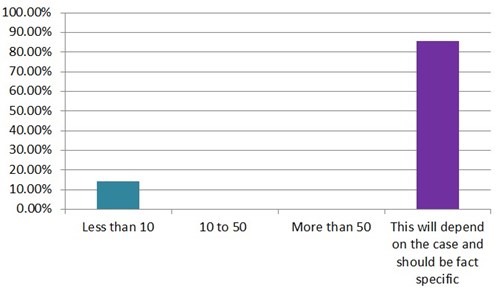
Most of the participants agree that it is case specific and we agree. Evidence should be provided to establish the design space but the amount of evidence will depend on the case.
QUESTION 15: If the Court in an appeal finds the design patent concerned does not include relevant drawings or pictures that clearly show the design of the products for which patent protection is requested (Article 27.2 of the China Patent Law), should the Court be able to declare the design patent right invalid directly (giving extra authority to the Court to prevent continued administrative proceedings)? (Article 23)
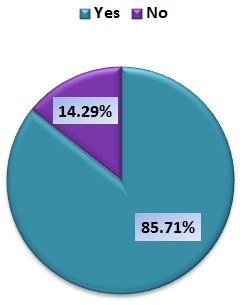
Most of the participants agree. We agree the Court can ascertain the facts of unclear defect. However, the Court should have the discretion to return the case to the PRB consistent with Question 10.
QUESTION 16: If two design patent applications having different applicants and the same filing date are directed to substantially the same design, should the first application to be granted retain the rights? [Note: (i) the applications will not normally be cited against each other so only the first to grant will proceed; (ii) if the 2 design patent applications have the same applicant only one of the applications can proceed and the applicant has the opportunity to choose] (Article 25)
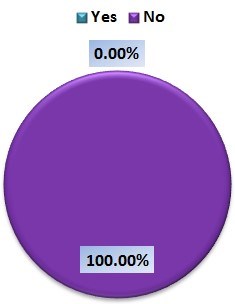
QUESTION 17: Following from question 16, if the first application to be granted is later found to be invalid due to fraudulent behaviour in filing the application, should the second application be allowed to proceed to grant? (Article 25)
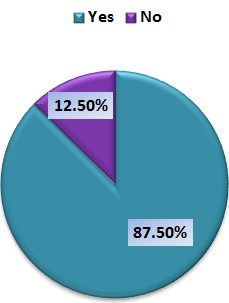
The overwhelming majority of the participants and we agree. The first granted design patent should not automatically get the rights. Further, if the PRB or Court later finds the first granted patent was obtained fraudulently from the other patent applicant, the other patent applicant should be awarded the patent right.
For more information, please contact our Head of Patent Strategy and Development, Tim Jackson.